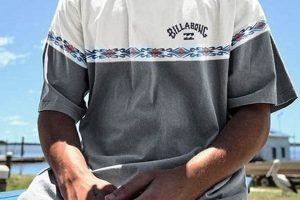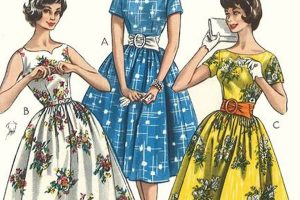Textiles produced in previous eras, typically spanning from the mid-20th century or earlier, often exhibit unique characteristics. These fabrics can range from delicate silks and durable woolens to printed cottons and novelty synthetics. Their composition, weave, and dyeing processes reflect the technologies and aesthetics prevalent during their time of manufacture. For example, a rayon crepe dress from the 1930s showcases the era’s fascination with innovative synthetic fibers and flowing silhouettes.
The appeal of these older textiles lies in their historical significance, inherent quality, and distinctive visual character. Many demonstrate craftsmanship and techniques that are less common in contemporary production. Their use allows for unique creative expression, contributing to sustainable practices through repurposing and upcycling. Furthermore, items crafted from these resources offer a tangible connection to the past, providing insight into earlier cultures and design trends.
The subsequent sections of this document will further explore specific types, preservation techniques, and applications of these sought-after textiles. Understanding their properties and history is critical for collectors, designers, and anyone interested in incorporating them into their creative work.
Guidance on Sourcing and Handling Older Textiles
The following guidelines are provided to assist in the acquisition, assessment, and proper maintenance of older fabrics.
Tip 1: Authenticate Provenance. Prior to acquisition, research the origin and age of the textile. Confirm its historical context through reliable sources, such as museum archives or expert appraisers. This aids in verifying the authenticity and value of the material.
Tip 2: Inspect for Deterioration. Thoroughly examine the fabric for signs of age-related damage, including dry rot, insect infestation, staining, and weakening of fibers. Employ appropriate lighting and magnification to detect subtle flaws.
Tip 3: Understand Fiber Content. Identify the specific fibers present in the textile. This is crucial for determining appropriate cleaning and preservation methods. Natural fibers, synthetics, and blends each require unique care protocols.
Tip 4: Test for Colorfastness. Before cleaning or treating the fabric, conduct a colorfastness test on an inconspicuous area. This prevents irreversible color bleeding or fading during the cleaning process.
Tip 5: Employ Gentle Cleaning Methods. Avoid harsh chemicals and aggressive cleaning techniques. Utilize pH-neutral detergents specifically designed for delicate textiles. Hand washing or professional dry cleaning are often the safest options.
Tip 6: Implement Proper Storage. Store textiles in a cool, dry, and dark environment. Use acid-free tissue paper to cushion folds and prevent creasing. Avoid direct sunlight, which can cause fading and fiber degradation.
Tip 7: Consider Professional Restoration. For significantly damaged or historically significant textiles, consult a professional textile conservator. These experts possess the specialized knowledge and skills necessary for effective restoration and preservation.
Adhering to these guidelines will contribute to the longevity and preservation of these valuable textile resources. Careful evaluation, handling, and storage are essential for maintaining their integrity for future generations.
The subsequent sections of this article will delve into specific applications and creative uses for these historically rich materials.
1. Fiber Composition
The fiber composition of older textiles profoundly influences their durability, aesthetic qualities, and preservation requirements. Natural fibers, such as cotton, linen, silk, and wool, were commonly employed, each possessing distinct characteristics. Cotton, for instance, offers breathability and absorbency, but is susceptible to mildew and degradation over time. Linen boasts strength and longevity but wrinkles easily. Silk provides luster and drape but is sensitive to light and abrasion. Wool provides warmth and resilience but is vulnerable to moth damage. The fiber content directly affects the fabric’s reaction to environmental factors and cleaning agents. Misidentification can lead to irreversible damage during conservation efforts, highlighting the significance of accurate fiber identification before any treatment is initiated.
The advent of synthetic fibers in the mid-20th century introduced rayon, acetate, and subsequent innovations to the textile landscape. These fibers, often blended with natural ones, presented novel properties like wrinkle resistance and enhanced durability. However, the long-term stability of early synthetics can be a concern. For instance, rayon, while initially prized for its silk-like appearance, can weaken and degrade over time, particularly when exposed to moisture. Identifying the presence and proportion of synthetic fibers within older textiles is therefore crucial for determining appropriate care protocols and anticipating potential degradation issues. Consider a 1950s dress labeled as “silk” that actually contains a rayon blend; improper cleaning intended for pure silk could cause irreparable harm.
Understanding the fiber composition of older textiles is paramount for their effective preservation and restoration. Accurate identification guides appropriate cleaning, storage, and repair techniques. This knowledge mitigates the risk of damage and ensures the continued enjoyment and study of these valuable historical resources. The complexities of fiber blends and the potential for degradation necessitate a careful and informed approach, emphasizing the crucial role of textile expertise in maintaining the integrity of these materials for future generations.
2. Weave Structure
Weave structure is a fundamental determinant of the properties and characteristics of older fabrics. The method by which threads interlock significantly impacts a fabric’s durability, drape, texture, and overall appearance. Different weave structures, such as plain, twill, satin, and jacquard, were favored in various eras, reflecting technological advancements and aesthetic preferences. A tightly woven fabric, for example, may exhibit greater resistance to wear and tear than a loosely woven one. The specific weave structure employed directly influences how the fabric responds to stress, cleaning, and other environmental factors. Therefore, an understanding of weave structure is essential for proper identification, conservation, and utilization of vintage textiles. As an illustration, a finely woven silk satin from the Art Deco period requires vastly different handling compared to a sturdy cotton twill from the same era.
The practical significance of recognizing weave structure extends to informed decision-making regarding cleaning, repair, and adaptation. A delicate satin weave, prone to snagging and distortion, demands gentle cleaning methods and careful handling. Conversely, a durable twill weave can withstand more rigorous treatment. When repurposing textiles, the weave structure dictates appropriate applications; a strong, tightly woven linen is better suited for upholstery than a sheer, loosely woven voile. Identifying the weave structure also aids in recreating or replicating textiles, allowing for accurate reproduction of historical garments or furnishings. For example, a researcher studying Civil War-era uniforms would need to understand the specific twill weave of the wool fabric to create an accurate replica.
In conclusion, weave structure represents a critical attribute of older fabrics, impacting their longevity, usability, and overall value. Its influence extends from conservation protocols to creative applications. Challenges in identifying and understanding complex weave structures necessitate careful examination and, in some cases, expert consultation. Recognizing the inherent relationship between weave structure and the properties of older textiles is fundamental to preserving these material artifacts and ensuring their continued appreciation. This knowledge informs responsible handling, appropriate applications, and accurate replication, contributing to the preservation of textile history.
3. Dyeing Techniques
Dyeing techniques employed in the production of older textiles significantly influence their aesthetic qualities, colorfastness, and historical value. The methods used to impart color to fabrics during different periods offer valuable insights into the technologies, materials, and cultural practices of the time.
- Natural Dyes and Their Characteristics
Prior to the advent of synthetic dyes, natural substances derived from plants, animals, and minerals were utilized to color textiles. These dyes, such as indigo, madder, and cochineal, often exhibit subtle variations in hue and can fade or change over time. Their presence in older fabrics provides clues about the geographical origin and intended use of the textile. Identifying natural dyes requires specialized knowledge and analytical techniques. Fabrics dyed with natural indigo, for instance, possess a distinct blue hue often found in 19th-century workwear, while madder produces a range of red shades common in historical textiles.
- Mordants and Dye Fixation
Mordants are substances used to fix dyes onto textile fibers, enhancing colorfastness and enabling a wider range of hues to be achieved. Common mordants include alum, iron, and tannin. The type of mordant used can affect the final color of the dyed fabric and its resistance to fading or washing. Historical records and chemical analysis can reveal the mordanting techniques employed in the production of older textiles. For example, the use of iron as a mordant can darken the color of certain dyes and contribute to the degradation of cellulose fibers over time, a factor that must be considered during conservation.
- Synthetic Dyes and the Rise of Color Consistency
The introduction of synthetic dyes in the late 19th century revolutionized the textile industry, offering a wider spectrum of colors, improved colorfastness, and greater consistency compared to natural dyes. Aniline dyes, the first commercially successful synthetic dyes, enabled mass production of brightly colored textiles. Identifying synthetic dyes requires microscopic examination and chemical testing. The presence of specific synthetic dyes in a fabric can help to determine its approximate age and origin, providing valuable information for dating and authentication. The vibrant hues achievable with synthetic dyes transformed fashion and design, impacting color palettes and aesthetic trends.
- Piece Dyeing, Yarn Dyeing, and Printing Techniques
The stage at which a textile is dyed whether as individual fibers, yarn, or a completed piece of fabric impacts the final appearance and characteristics of the dyed material. Piece dyeing, where the entire fabric is immersed in dye, is a common and economical method. Yarn dyeing allows for the creation of patterned fabrics, such as plaids and stripes. Printing techniques, such as block printing and roller printing, enable the application of intricate designs and motifs. The dyeing technique employed influences the color penetration, pattern clarity, and overall aesthetic of the textile. For instance, resist dyeing methods like batik and ikat produce unique patterns characterized by irregular lines and nuanced color variations.
The study of dyeing techniques provides a crucial lens through which to examine older textiles. By understanding the materials, methods, and technologies employed in the dyeing process, it is possible to gain deeper insights into the historical context, cultural significance, and material properties of these valuable artifacts.
4. Historical Context
The historical context surrounding a piece of vintage textile is not merely ancillary information; it is an integral component that defines its value, authenticity, and significance. The specific era of production, the socio-economic conditions prevalent at that time, and the technological advancements available all directly influenced the materials used, the manufacturing processes employed, and the intended purpose of the textile. Understanding this cause-and-effect relationship is paramount to accurately assessing and appreciating a vintage cloth material. For example, a silk brocade woven in Lyon during the 18th century reflects the advanced jacquard looms of the period and the patronage of the French court, imbuing it with a distinct historical narrative absent from a similar modern reproduction. The historical context informs the provenance, influencing its desirability to collectors and researchers.
Furthermore, the practical significance of this understanding extends to conservation and restoration efforts. Knowing the intended use of the textile, whether it was a garment, an upholstery fabric, or a ceremonial banner, dictates appropriate preservation techniques. A textile intended for frequent use might have been treated with processes designed for durability, while a purely decorative piece could have employed more delicate techniques. Recognizing the specific dyeing processes and fiber treatments prevalent in a particular era informs the selection of cleaning agents and repair methods, minimizing the risk of further damage. Consider the challenge of conserving a quilt made during the Great Depression; recognizing the resourcefulness of the era, utilizing repurposed fabrics and simple stitches, guides a conservator to preserve the inherent character rather than striving for a pristine, historically inaccurate restoration.
In conclusion, the historical context acts as a framework through which vintage textiles are understood and valued. Ignoring this context leads to misinterpretation, potential damage, and a diminished appreciation of their true worth. Challenges lie in the often incomplete historical records and the need for interdisciplinary expertise involving historians, textile conservators, and material scientists. Accurately interpreting and communicating the historical context enriches the understanding and preservation of these material artifacts, connecting them to the broader tapestry of human history.
5. Condition Assessment
Condition assessment is a critical and inseparable component when evaluating vintage cloth material. The physical state of a textile directly affects its value, usability, and appropriate conservation strategies. Factors contributing to deterioration include fiber degradation, staining, structural damage (tears, holes, weakened seams), and the presence of pests or mold. These conditions arise from a combination of environmental exposure, use patterns, and inherent properties of the fibers themselves. For example, a 1920s silk dress stored improperly could exhibit severe shattering due to the breakdown of the silk fibers, rendering it fragile and significantly impacting its market value compared to a similar dress in excellent condition. Without a thorough condition assessment, appropriate preservation methods cannot be accurately determined, potentially leading to further damage.
Practical applications of condition assessment extend to diverse areas. Museums use condition reports to track the state of textiles in their collections and to justify conservation treatments. Antique dealers rely on accurate assessments to price items appropriately and to inform potential buyers of any existing flaws. Fashion designers incorporate condition into their decisions about repurposing older fabrics, selecting materials strong enough for their intended designs. For instance, a tapestry with sun fading might be unsuitable for display but could be cut and incorporated into smaller, less exposed items, ensuring the remaining areas are preserved. Proper assessment dictates informed decisions regarding cleaning methods. A heavily soiled velvet garment could be structurally unsound, rendering wet cleaning too risky, requiring dry cleaning or surface cleaning instead.
In conclusion, condition assessment is not merely a procedural step but a fundamental aspect of understanding and working with vintage cloth material. Challenges include subjective interpretations of condition levels and the limitations of non-destructive testing methods. The goal is to provide objective, evidence-based evaluations that inform preservation and utilization decisions. By integrating detailed condition assessments, stakeholders can ensure the longevity and continued appreciation of these valuable historical artifacts, connecting their preservation to broader themes of cultural heritage and material science.
Frequently Asked Questions
This section addresses common inquiries regarding the characteristics, identification, preservation, and utilization of textiles originating from previous eras.
Question 1: What constitutes “vintage cloth material” and what distinguishes it from antique or contemporary fabrics?
The term generally refers to textiles produced between approximately 20 and 100 years ago. Antique fabrics typically predate this timeframe, while contemporary fabrics represent modern production. Distinguishing characteristics include fiber composition, weave structures, dyeing techniques, and overall aesthetic styles prevalent during their respective periods.
Question 2: How can one ascertain the authenticity and age of a piece of vintage cloth material?
Authenticating involves examining fiber content, weave structure, and dyeing methods. Researching historical context, including manufacturing practices and prevalent styles of the period, is critical. Consulting with textile experts or appraisers provides further validation.
Question 3: What are the primary concerns regarding the preservation of vintage cloth material?
Degradation due to environmental factors such as light, humidity, and temperature is a primary concern. Insect infestation and improper handling also contribute to deterioration. Staining and physical damage, such as tears and weakened seams, require specialized conservation techniques.
Question 4: What cleaning methods are appropriate for vintage cloth material, and what should be avoided?
Gentle cleaning methods are essential. Hand washing with pH-neutral detergents designed for delicate textiles is often preferred. Harsh chemicals, aggressive agitation, and high heat should be avoided. Professional dry cleaning, when appropriate, requires selecting a cleaner experienced with antique and vintage textiles.
Question 5: How should vintage cloth material be stored to prevent damage?
Storage in a cool, dry, and dark environment is recommended. Acid-free tissue paper should be used to cushion folds and prevent creasing. Avoid direct sunlight and high humidity. Garments should be stored flat or on padded hangers to prevent distortion.
Question 6: What are some appropriate and ethical ways to repurpose vintage cloth material?
Repurposing should be approached with sensitivity to the textile’s historical significance. Utilizing damaged or incomplete pieces is often a responsible choice. The new application should respect the original character of the material. Conservation or stabilization efforts should be prioritized before repurposing to prevent further degradation.
Careful handling, appropriate preservation techniques, and informed decision-making are crucial when working with vintage cloth material. Understanding its unique properties and historical context ensures its longevity and continued appreciation.
The following section explores case studies and examples of successful preservation and repurposing efforts involving vintage cloth material.
Conclusion
The preceding discussion has underscored the multifaceted nature of vintage cloth material. Its intrinsic qualities, historical significance, and diverse applications necessitate a nuanced approach. Understanding fiber composition, weave structure, dyeing techniques, and the broader historical context are essential for effective preservation and utilization. Thorough condition assessment is paramount in determining appropriate conservation strategies.
Continued research, responsible handling, and informed decision-making are crucial for ensuring the long-term survival and appreciation of these irreplaceable resources. The preservation of textiles originating from previous eras contributes to a richer understanding of human history, technological advancements, and cultural aesthetics. Sustained efforts in this area are vital for connecting future generations with the material heritage of the past.







